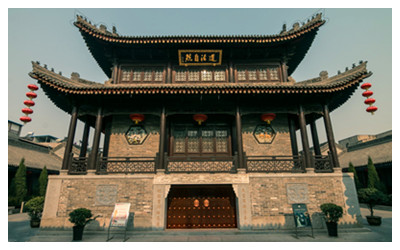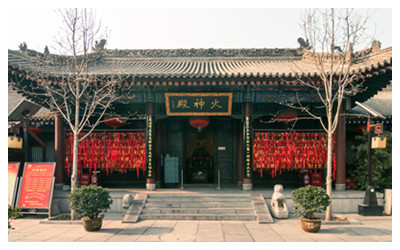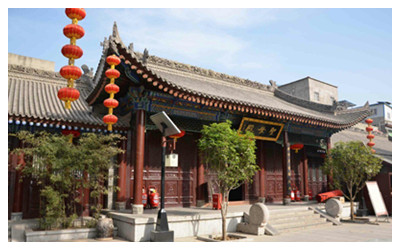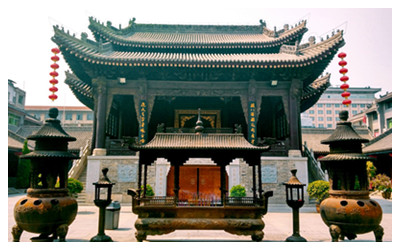Skype: neodalle-travel
Tel: +86 135 7447 2266
E-mail: sales@visitaroundchina.com
 Xian City God Temple is located on West Avenue in downtown Xian. It is the largest city god temple in Shaanxi Province. As one of the only two remaining Taoist temples in downtown Xian, it has been listed as a key historical and cultural site under state protection. With a history of more than 600 years, the temple is still a magnificent site today.
Xian City God Temple is located on West Avenue in downtown Xian. It is the largest city god temple in Shaanxi Province. As one of the only two remaining Taoist temples in downtown Xian, it has been listed as a key historical and cultural site under state protection. With a history of more than 600 years, the temple is still a magnificent site today.
First built in the twentieth year (1387) of the reign of Emperor Hongwu in the Ming Dynasty on the Jiuyao Street within the East Gate of the City Wall, the temple was rebuilt at its current location in the eighth year (1432) during the reign of the Ming Emperor Xuande. Being one of the three largest capital town god temples in China at that time, the Xian City God Temple, also known as Capital City God Temple, exercised control over all town god temples in China’s northwest provinces. Originally, the temple was very grand and included a main hall, a sleeping hall, subordinate halls, the Music and Dance Building, and a memorial archway. As time went on, only the hall which was rebuilt in the first year (1723) of the reign of Emperor Yongzheng in the Qing Dynasty (1644-1911) remains.It was in 2006 when the local government started to fund the restoration of the temple.
What to see?
 Xian Town God Temple mainly consists of the archway, the Pavilion of the God of Literature, the Gate of Etiquette, the Hall of Birth Year, the Ancestral Hall of Loyalty and Filial Piety, the Music and Dance Building, the Hall of Fire God, the Hall of the Queen of Heaven, and the Hall of City God.
Xian Town God Temple mainly consists of the archway, the Pavilion of the God of Literature, the Gate of Etiquette, the Hall of Birth Year, the Ancestral Hall of Loyalty and Filial Piety, the Music and Dance Building, the Hall of Fire God, the Hall of the Queen of Heaven, and the Hall of City God.
Archway and Openings
The archway comprises five openings sustained by six major pillars, twelve subordinate ones, and twelve supporting ones. With a length of 32 meters, a width of 8.1 meters and a height of 14.5 meters, so grand an archway is very rare in China. On the front side of the archway hangs a plaque bearing the inscription “City God Temple” while the plague on the rear side reads “Have You Arrived Here?” All the characters were in the style of famous calligrapher, Yan Zhenqing in the Tang Dynasty (618-907). The middle opening is the main one. It is decorated with a painting which portrays two dragons playing with a pearl on the peacock blue background. The two openings beside the main one are subordinate ones, on each one of which a dragon and a phoenix are carved on a green background.
Music and Dance Building
 The Music and Dance Building stands between the Gate of Etiquette and a yard. To the left of the yard is the Hall of the Fire God. The Fire God is consecrated here who exercises control over Fire. To the right of the yard is the Hall of the Queen of Heaven. It houses the Queen of Heaven, the leader of all the female immortals. She blesses marriages and procreations.
The Music and Dance Building stands between the Gate of Etiquette and a yard. To the left of the yard is the Hall of the Fire God. The Fire God is consecrated here who exercises control over Fire. To the right of the yard is the Hall of the Queen of Heaven. It houses the Queen of Heaven, the leader of all the female immortals. She blesses marriages and procreations.
Hall of City God
The Hall of City God, the main hall in the temple, is located to the north of the yard. The City God worshipped in the hall is the Great General Ji Xin of the Han Dynasty (202 BC-220 AD). He was a loyal general under the leadership of Liu Bang and made great contributions to the establishment of the Han Dynasty. After Liu Bang ascended to the throne, Ji Xin was consecrated in temples all over the country to protect local people from danger.
Drum Music
Drum Music is an essential cultural relic in the Xian City God Temple. It is well known as being “the live fossil of ancient Chinese music” and “the symphony of ancient Xian”. The Drum Music Band of this temple was restored in 2005. The band has performed in Beijing, Hainan, Hong Kong, Jordan and other places. In addition, the band has taken part in the Euro-Asia  Economic Forum, the ceremony of the starting point of the Silk Road, the international Taoist forum, and other international conferences. In 2009, their Drum Music was listed as an intangible cultural heritage by the United Nations Educational, Scientific and Cultural Organization.
Economic Forum, the ceremony of the starting point of the Silk Road, the international Taoist forum, and other international conferences. In 2009, their Drum Music was listed as an intangible cultural heritage by the United Nations Educational, Scientific and Cultural Organization.
Temple Fair
The temple fair is held twice a year. One lasts from the first to the fifteenth day of the first lunar month while the other is held on the eighth of the fourth lunar month. The temple fair provides a perfect platform for commodity transactions and social activities. In 2009, the distinctive temple fair was listed as a provincial intangible cultural heritage.
Travel Tips
Entrnce Fee: free
Opening Hours: 09:00-18:00
How to get there: Take bus No. 4, 7, 15, 23, 31, 32, 43, 45, 201, 205, 215, 218, 221, 222, 251, 252, 300, 604, 611, 612, 618, 622, or Tourist Line 8 (610), and get off at Guangjijie Station.
 Ask Questions ?
Ask Questions ?